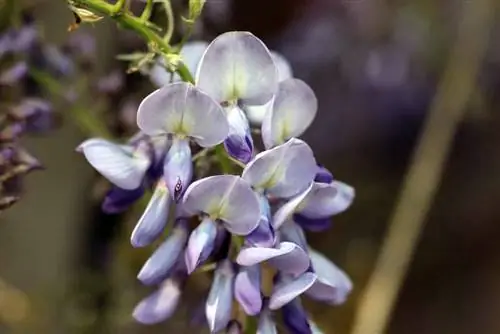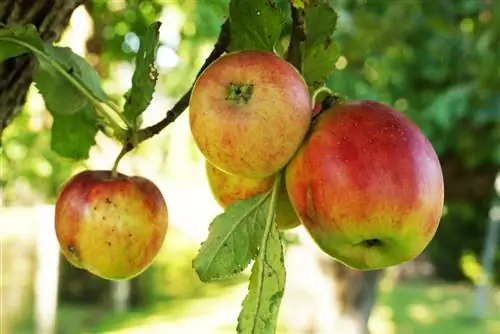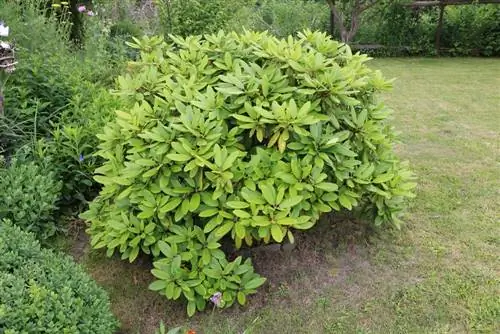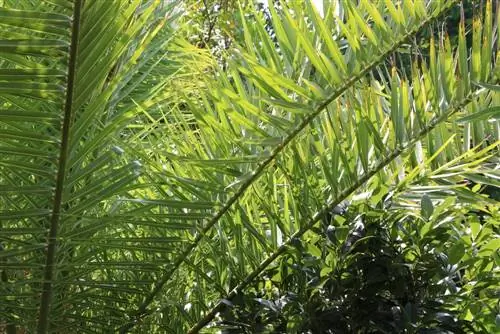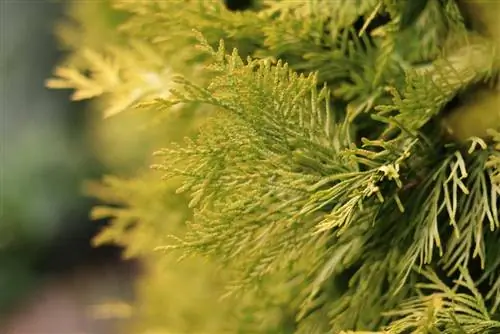- Author admin [email protected].
- Public 2023-12-17 03:39.
- Last modified 2025-01-24 12:45.
The hydrangea (Hydragenea) from the hydrangea family (Hydrangeaceae) has been loved and cultivated as a garden plant for centuries because of its eye-catching inflorescences. They originally come from Asia. Most species are deciduous and relatively hardy to very hardy. The lush inflorescences attract attention with their striking colors and shapes. Around 100 species of Hydragenea are known. Depending on their growth, they can be planted as a single shrub, as a group planting, ground cover or even as a climbing plant and informal hedge.
Height and cut
You often hear that hydrangeas should not be pruned. That's not quite right. Depending on the desired shape or age, it may be necessary to prune them. What the hydrangea cannot tolerate, however, is radical pruning. If you want a certain shape and height for your garden, you should pay attention to which variety you are buying when shopping. The different Hydragenea species and cultivated varieties offer a wide range, also in terms of height, from 50 cm to over seven meters.
bush, tree
As a bush, the hydrangea can offer almost any color and size. Larger Hydragenea species that grow wide and sprawling are often placed in the garden as a single eye-catcher. Bush hydrangeas are more suitable for group planting; they are smaller and more delicate and can be planted in groups on a bed.
It is also possible to grow certain species into a tree with regular pruning.
The following are some examples of species and varieties suitable for these plantings:
Farmer hydrangea (Hydrangea macrophylla)
The farmer's hydrangea is one of the most popular hydrangeas that grows in our pots and gardens. It is also known as garden hydrangea, potted hydrangea or Japanese hydrangea. It grows easily and can grow up to two meters high.
Popular varieties are:
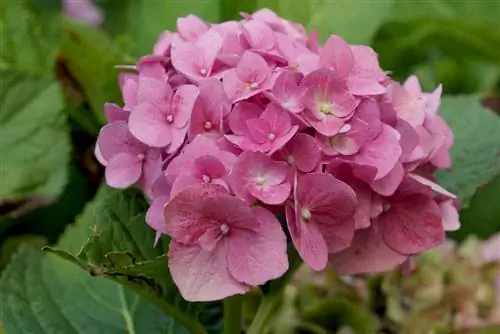
Hydrangea macrophylla ‘Alpenglow’
spherical red flowers; annual growth 25 cm; Height up to 1, 50 m
Hydrangea macrophylla ‘Masja’
very large pink spherical flowers; annual growth 50 cm; Height up to 1, 30 m
Hydrangea macrophylla ‘Harmony’
grows particularly strongly (3 m high and wide) with long flower umbels
Hydrangea macrophylla ‘Snow Queen’
Height up to two meters; white, long flowers; Leaves turn dark red in autumn
Velvet hydrangea (Hydrangea aspera)
An exceptional shrub hydrangea is the velvet hydrangea, also known as the rough hydrangea. It stands out because of its velvety leaves, some of which appear huge. The growth is flat, spherical and up to a good two m high. Her special appearance makes her perfect for a solo position.
Popular varieties are:
Hydrangea aspera ‘Macrophylla’
large flower umbels; large leaves; white false flowers with purple true flowers inside; can grow up to 3.50 m high
Hydrangea aspera 'Hydrangea aspera ssp. sargentiana‘
large leaves; bicolor (mock) flowers white and pink; usually stays under two meters
Hedge
A hydrangea hedge does not provide year-round privacy or noise protection. It is also not suitable as a tight fence for a property. This is why it is also referred to as an informal hedge. Informal hedges are defined as a loose boundary that tends to suggest a boundary through alternating, flowering, loosely growing natural shrubs. They do not represent an insurmountable, dense obstacle, such as a thuja or privet hedge.
Nevertheless, a hydrangea hedge is something very special and there are some species and varieties that are ideal for it. They are generally fast-growing and easy to cut back. Below are some examples of hydrangea species and varieties that are particularly suitable for hedge planting:
Oak-leaved hydrangea (Hydrangea quercifolia)
The flowers of this variety are panicle-shaped. As a shrub, they usually reach a height of up to two meters. The beautiful large leaves turn a bright red-purple in autumn. Oakleaf hydrangeas tend to grow widely, which is something to keep in mind when creating a hedge. It grows 20 to 30 cm per year. A big advantage for hedge planting is that they can tolerate almost all locations from sunny to shady and can also tolerate wind.
Hydrangea quercifolia ‘Burgundy’
white panicle-shaped (mock) flowers; Leaves turn pinkish-red in autumn; height up to 1.50 m; Width up to 2 m
Hydrangea quercifolia ‘Harmony’
particularly large, white (mock) flowers: branches need to be partially supported; Height up to 1.50 m; Width up to 2 m
Hydrangea quercifolia ‘Snow Queen’
Branches very stable with large flowers; magnificent autumn color of the foliage: height up to 1.50 m; Width up to 2 m
Forest hydrangea (Hydrangea arborescens)
The bushes of the forest hydrangeas are slightly taller than the oak-leaved hydrangeas. In terms of their appearance, their growth and their tolerance to cutting, they are also very suitable for a hedge. Visually attractive varieties are:
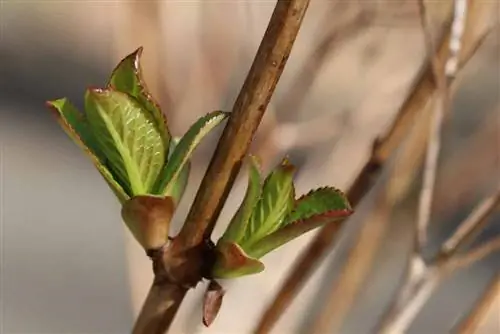
Hydrangea arborescens ‘Annabelle’
also called ball hydrangea 'Annabelle'; light green to white, spherical, large flowers; annual height increase of up to 80 cm; but has to be cut back heavily every year; average height 1, 50 m
Hydrangea Arborescens ‘Grandiflora’
most widespread; lots of creamy white flowers; grows wide, dense and upright; height up to 2 m; Width approx. 1, 50 m
Farmer hydrangea (Hydrangea macrophylla)
There are also some varieties of farmer's hydrangeas that are ideal for hedge planting:
Hydrangea macrophylla ‘Alpenglow’
dark pink to red flowers; extremely easy to care for; very fast and densely growing: height up to 1.50 m; width up to 130 cm; approx. 25 cm growth per year
Hydrangea macrophylla ‘Bodensee’
dense, spherical, blue-purple flowers; very hardy; Annual growth 20 to 30 cm; height up to 1.30 m; Width 1, 20 m
Group planting, ground cover
Using several hydrangeas in the bed as a group or as ground cover is not that common. The varieties of plate hydrangeas (also: mountain hydrangeas) are particularly suitable for this purpose. They naturally remain very low and enrich many beds with their plate-shaped, colorful flower umbels.
Hydrangea serrata
Hydrangea serrata ‘Blue Deckle’
light blue to soft pink flowers; height 1.20 m; slowly growing
Hydrangea serrata ‘Bluebird’
light to dark blue flowers; height up to 1.50 m; Wide 100 to 125 cm; Annual growth 10 to 35 cm
Hydrangea serrata ‘Koreana’
also: dwarf hydrangea 'Koreana'; lots of pink flowers; compact, low growth; forming runners; still relatively unknown; Height and width approx. 50 cm; Annual growth up to 15 cm
Tree
A hydrangea trained as a tree is rare. This works best with the panicle hydrangea (Hydrangea paniculata). It is very fast-growing and reaches several meters high. They are characterized by elongated lilac-like flower spikes. Popular varieties of this relatively unknown hydrangea variety are:
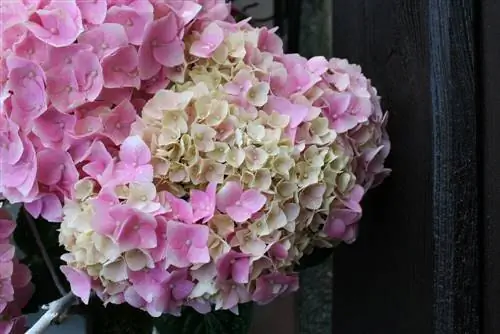
Hydrangea paniculata ‘Grandiflora’
most widespread; white-pink flower spikes up to 30 cm long; Growth height approx. 2 m; Annual growth 20 to 35 cm
Hydrangea paniculata ‘Unique’
creamy white panicles; Height up to 3 m: annual growth up to 30 cm
Hydrangea paniculata ‘Tardiva’
small, late-blooming flower spikes; loose, upright growth; broad-bushy; Height 2.50 to 3.50 m; Annual growth up to 35 cm
Hydrangea paniculata ‘Kyushu’
fragrant, large white flowers; very easy to grow in width and height; height up to 3 m; Annual growth up to 40 cm
climbing plant
A very unusual growth form in our gardens is the hydrangea as a climbing plant. There is the white-flowering Hydrangea petiolaris. This climbing hydrangea can grow over 15 m long. They form small adhesive roots and climb up walls, trees or other supports. The climbing hydrangea is ideal for shady north-west and west walls. However, for a climbing plant it grows rather slowly.
Conclusion
In fact, hydrangeas offer one or more perfectly suited species for every purpose. You rarely see them, especially as a tree, as a ground cover and as a hedge. Almost all species are striking because of their lush flowers and the foliage also turns the most beautiful shades of red in autumn. This and their hardiness compensate for the fact that they lose their leaves in winter.


